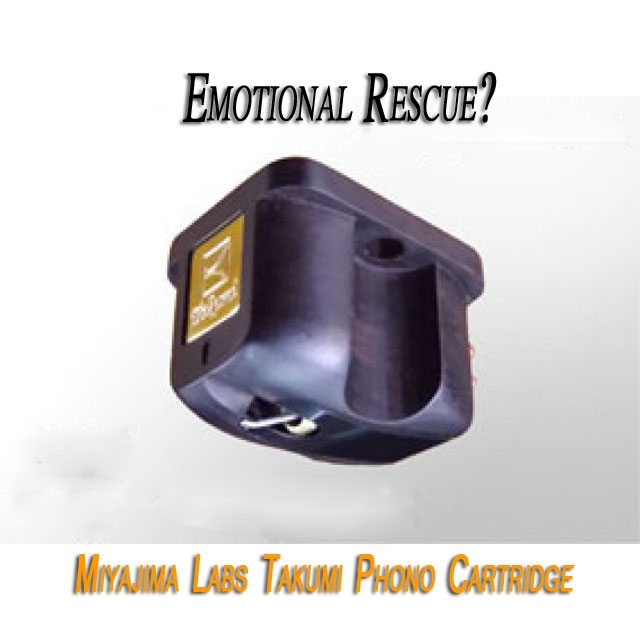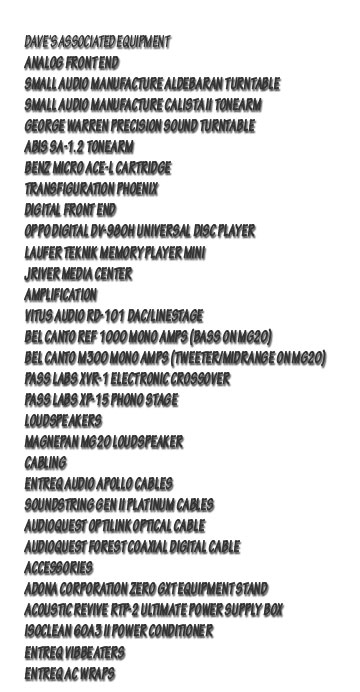Miyajima Labs Takumi Phono Cartridge

 During the past year, I had the opportunity to spend some time with a couple of very fine phono cartridges from a relatively new company called Aidas: the $3,000 Black Sound-Red Heart and $8,000 Mammoth Gold. I was so taken by the virtues of both of these cartridges that they left a bit of an emotional void once they were gone. Especially the Mammoth Gold which is special in its ability to render a live venue. A few weeks later, I started looking into other cartridges that I thought might be able to give me what I missed about those cartridges; excellent craftsmanship, unique design and performance that allows you to get into the realism and dynamics of live music. But I’m also looking for a cartridge that delivers the emotional impact that can only come from a brilliant solo performance (think Funkadelic’s Eddie Hazel playing “Maggot Brain”). So, with that criteria in mind, I reached out to Robin Wyatt of Robyatt Audio, the U.S. distributor of the highly regarded Miyajima Labs line of phono cartridges, and a few weeks later, the “Takumi,” Miyajima’s entry level stereo cartridge arrived for review.
During the past year, I had the opportunity to spend some time with a couple of very fine phono cartridges from a relatively new company called Aidas: the $3,000 Black Sound-Red Heart and $8,000 Mammoth Gold. I was so taken by the virtues of both of these cartridges that they left a bit of an emotional void once they were gone. Especially the Mammoth Gold which is special in its ability to render a live venue. A few weeks later, I started looking into other cartridges that I thought might be able to give me what I missed about those cartridges; excellent craftsmanship, unique design and performance that allows you to get into the realism and dynamics of live music. But I’m also looking for a cartridge that delivers the emotional impact that can only come from a brilliant solo performance (think Funkadelic’s Eddie Hazel playing “Maggot Brain”). So, with that criteria in mind, I reached out to Robin Wyatt of Robyatt Audio, the U.S. distributor of the highly regarded Miyajima Labs line of phono cartridges, and a few weeks later, the “Takumi,” Miyajima’s entry level stereo cartridge arrived for review.
Miyajima Labs
Mr. Noriyuki Miyajima started Miyajima Labs in Fukuoka-City, Japan back in 1980. While the company is best known for their world class stereo and mono phono cartridges, they also produce a tube preamp, amplifier, a MC step up transformer and other high-end audio products. All Miyajima cartridges bear a strong family resemblance due to their use of some gorgeous exotic hardwood bodies and hand sculpted gold accents. Though not exactly jewelry, the Takumi that I was sent, did come in a lovely red velvet jewel case (my wife didn’t quite get how something that came in a red jewel case didn’t belong to her, but she eventually got over it).
The Takumi
Many a high-end audio company has been started by a gifted genius who simply saw a different way to approach a common audio design element. In this case, Mr. Miyajima’s focus has been to improve on conventional designs in phono cartridges. The improvement in this case is called the “cross ring” motor assembly. According to his website, when the right and the left coils cross, their middle points overlap. Miyajima makes the middle point the fulcrum of the movement. By this method, each coil does rotary motion to the movement of the stylus. Therefore, electricity can be caused only with a coil without needing the armature of the iron core. The movement is not affected in magnetic flux, and the light weight can produce it. This results in a reduction of distortion and allows Miyajima cartridges to perform optimally.
 The Takumi may be Miyajima’s entry-level stereo cartridge, but that only means that it is the least expensive. Believe me, its beauty, build quality and thoughtful design makes it every bit a reference quality cartridge. Its body is made of a gorgeous African Blackwood that is lightweight but strong, and it has a fairly compliant bonded elliptical diamond stylus. The result is a cartridge that weighs only 9.0g and requires a tracking force of 2.3g.
The Takumi may be Miyajima’s entry-level stereo cartridge, but that only means that it is the least expensive. Believe me, its beauty, build quality and thoughtful design makes it every bit a reference quality cartridge. Its body is made of a gorgeous African Blackwood that is lightweight but strong, and it has a fairly compliant bonded elliptical diamond stylus. The result is a cartridge that weighs only 9.0g and requires a tracking force of 2.3g.
Mr. Miyajima recommends using this low-output cartridge with a step-up transformer instead of an active gain stage. Thankfully, I still have the fabulous Pyon Sound MC Master moving coil SUT that I reviewed back in September of 2015. As much as I love my Pass phonostage, I have to go with the manufacturer’s recommendation. So out with the Pass, in with the Pyon.
System Setup
The reference system for this review consists of the enigmatic Small Audio Manufacture (S.A.M.) Aldebaran turntable and Calista II tonearm. I say “enigmatic” because the Internet has been buzzing about this Croatian company that has been building what look like $10,000 turntables but only selling them for around $2,000 (with arm!). It seems the only way to get one is either direct from the manufacturer or through eBay. I got mine from the manufacturer after a strong recommendation from Clement Perry. It’s a shockingly well-built table and arm, and sounds fantastic. Prior to the Takumi’s arrival I was using a Benz Micro Ace-L low output moving coil cartridge as my reference but also spent some time with the Transfiguration Phoenix and the Aidas Black Sound-Red Heart and Mammoth Gold cartridges. My phonostage is the Pass Labs XP-15.
My digital front-end consists of the Laufer Teknik Memory Player Mini and an OPPO DV980H Universal Disc Player. Both units feed a Vitus Audio RD-101 DAC/linestage. The system is anchored by my Magneplanar MG20s being driven by two pairs of Bel Canto mono amps (M300s for the tweeter/midrange. REF1000Ms for the bass). This configuration is controlled by the Pass Labs XVR-1 electronic crossover. Most of the cabling is the Soundstring GEN II Platinum except for the AudioQuest Forest digital cables. All components sit on a rock-solid Adona Corporation Zero GXT equipment rack.
It’s All About the Beef!
With this being my third cartridge review in the last twelve months, I have come to truly appreciate analog as a medium for evaluating how music is reproduced. Analog, to my ears is still a more “true to life” form of recording and reproduction than digital. I remember going into a neighborhood burger joint with my dad and watching him take in a deep breath and proclaim that the best part of getting a burger from a joint like that was “the smell of the beef in the air.” A few weeks later, on a trip to McDonald’s, he once again put his nose in the air, inhaled, and asked “if they sell hamburgers here, how come I can’t smell the beef?” Now, dear old dad (R.I.P.) wasn’t exactly a connoisseur of fine dining, but as crude as the analogy may have been I think it speaks to the heart of the analog vs. digital debate. There is just a little bit more of “something” in analog that you don’t get in digital. But let’s move on.
 My adventures with cartridges had the residual effect of my buying a load of new vinyl. One of my favorites is an audiophile re-issue of Loggins & Mesina’s Full Sail [Direct Disc Labs B077H3PPWC] which features a lot of great songs but my favorite is of course the iconic “Pathway to Glory.” You should pick this album up just for the drum work by Merl Bregante alone. If your system has enough upper extension air, the cymbal crashes alone will consume you. This is a classic ‘70s rock song. The kind of tune that makes being an audiophile worthwhile. The Takumi handles this type of multi-layered rock song about as well as can be expected considering that the final quarter of the song features drums, cowbell, lead guitar, acoustic guitar, cymbals, violins, tambourine and organ. “Watching the River Run” is another song from this album but it’s the complete opposite of Pathway to Glory as dynamics go, but Kenny Loggins’ mellifluous vocals more than make up for it. Songs like this allow the Takumi to shine. This cartridge excels at subtlety and nuance and does a wonderful job of fleshing out vocal performances.
My adventures with cartridges had the residual effect of my buying a load of new vinyl. One of my favorites is an audiophile re-issue of Loggins & Mesina’s Full Sail [Direct Disc Labs B077H3PPWC] which features a lot of great songs but my favorite is of course the iconic “Pathway to Glory.” You should pick this album up just for the drum work by Merl Bregante alone. If your system has enough upper extension air, the cymbal crashes alone will consume you. This is a classic ‘70s rock song. The kind of tune that makes being an audiophile worthwhile. The Takumi handles this type of multi-layered rock song about as well as can be expected considering that the final quarter of the song features drums, cowbell, lead guitar, acoustic guitar, cymbals, violins, tambourine and organ. “Watching the River Run” is another song from this album but it’s the complete opposite of Pathway to Glory as dynamics go, but Kenny Loggins’ mellifluous vocals more than make up for it. Songs like this allow the Takumi to shine. This cartridge excels at subtlety and nuance and does a wonderful job of fleshing out vocal performances.
 Though she is best known for her musicianship on the upright bass, Esperanza Spaulding’s vocals are downright hypnotic. On her best album (IMHO) Radio Music Society [Heads Up] she has a couple of songs that showcase her magnificent voice: “Hold On Me” and “Smile Like That.” Hold On Me is a classic jazz ballad that Spaulding delivers from the heart. I’ve heard her sing this song live and it is downright emotional. The Takumi does a good job of rendering the orchestra that plays behind her and a spectacular job of portraying Spaulding’s sumptuous voice. As I mentioned before, it’s the subtleties and nuance that this cartridge excels at. That’s where the magic in analog recordings rests. The reverse would not be nearly as satisfying.
Though she is best known for her musicianship on the upright bass, Esperanza Spaulding’s vocals are downright hypnotic. On her best album (IMHO) Radio Music Society [Heads Up] she has a couple of songs that showcase her magnificent voice: “Hold On Me” and “Smile Like That.” Hold On Me is a classic jazz ballad that Spaulding delivers from the heart. I’ve heard her sing this song live and it is downright emotional. The Takumi does a good job of rendering the orchestra that plays behind her and a spectacular job of portraying Spaulding’s sumptuous voice. As I mentioned before, it’s the subtleties and nuance that this cartridge excels at. That’s where the magic in analog recordings rests. The reverse would not be nearly as satisfying.
To understand the Takumi’s abilities with more up tempo fare, I called on one of my favorite albums for gauging my system’s ability to render the dynamics and nuance’s of a live recording: Patricia Barber’s Live: A Fortnight In France [Blue Note]. This 200 gram, two-disc pressing comes as close to recreating a live event in my home as any recording I own. As soon as you hear the French speaking voice of the gentleman introducing Barber pierce the quiet of your listening space, your room is immediately transformed into what feels like a lively space, filled with a live audience. Then the music begins, and as you first hear the hammers strike the strings inside of Barber’s Steinway, you’re reminded of the percussive nature of the piano. This is where the Takumi is at its finest. The next few songs are more of the same until I got to a particularly dynamic track called “White World.” This track features a neat little guitar rhythm line that the Takumi delineates well. It also holds its composure well when combined with drums, a triangle, bongos and of course Barber’s voice. But what really gets your appreciation for what the Takumi does is the way that you can sense the size of the venue and hear the excitement in the audience’s applause. That’s what really gives you that feeling of being at the performance. Hearing Barber thank the fans in French is pretty cool too.
Conclusion
The Takumi is a serious reference quality cartridge, and I’m seriously thinking of making it my reference cartridge. That’s saying something, because I have loved my Benz Micro Ace for a long time. It’s not perfect, I wouldn’t feed it a steady diet of my Parliament/Funkadelic albums. Rendering a wave of synthesizers and throbsonics-butt-thumping-bass just isn’t its thing. But if you’re looking to settle into the sweet spot, dim the lights, poor yourself a nice glass of Riesling and be transported to an intimate music venue, then you can’t go wrong with the Miyajima Labs Takumi. Its sound and build quality make it worth seeking out and its price tag makes it a serious bargain. Considering that this is their least expensive cartridge, I’m really curious about what a little more money might get. It’s hard to imagine more. Highly recommended.


dave thomas
Specifications:
Price: $1,895.00 USA
Contact:
Miyajima Labs
4-3-25
Chayama
jounan-ku
fukuoka-city, fufuoka
814-0111
Japan
U.S. Distributor
Robyatt Audio

Stereo Times Masthead
Publisher/Founder
Clement Perry
Editor
Dave Thomas
Senior Editors
Frank Alles, Mike Girardi, Russell Lichter, Terry London, Moreno Mitchell, Paul Szabady, Bill Wells, Mike Wright, and Stephen Yan,
Current Contributors
David Abramson, Tim Barrall, Dave Allison, Ron Cook, Lewis Dardick, John Hoffman, Dan Secula, Don Shaulis, Greg Simmons, Eric Teh, Greg Voth, Richard Willie, Ed Van Winkle, Rob Dockery, Richard Doron, and Daveed Turek
Site Management Clement Perry
Ad Designer: Martin Perry








Be the first to comment on: Miyajima Labs Takumi Phono Cartridge